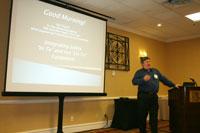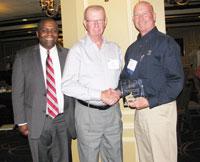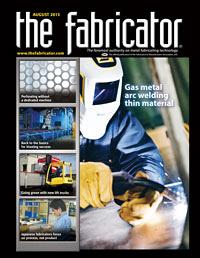Editor-in-Chief
- FMA
- The Fabricator
- FABTECH
- Canadian Metalworking
Categories
- Additive Manufacturing
- Aluminum Welding
- Arc Welding
- Assembly and Joining
- Automation and Robotics
- Bending and Forming
- Consumables
- Cutting and Weld Prep
- Electric Vehicles
- En Español
- Finishing
- Hydroforming
- Laser Cutting
- Laser Welding
- Machining
- Manufacturing Software
- Materials Handling
- Metals/Materials
- Oxyfuel Cutting
- Plasma Cutting
- Power Tools
- Punching and Other Holemaking
- Roll Forming
- Safety
- Sawing
- Shearing
- Shop Management
- Testing and Measuring
- Tube and Pipe Fabrication
- Tube and Pipe Production
- Waterjet Cutting
Industry Directory
Webcasts
Podcasts
FAB 40
Advertise
Subscribe
Account Login
Search
Safety: The never-ending battle
The FMA Safety Conference 2013 proves that safety needs to be an ongoing concern

Figure 1: At FMA’s 2013 Safety Conference, Ken Frizzell, senior manufacturing engineer, body assembly maintenance, Nissan North America Inc., discussed the automaker’s evolution from thinking of safety as an afterthought to making it a part of every meeting and discussion related to automated workcell conception, development, and installation. That shift in thinking has helped the manufacturer be more aware about safety, but it’s a constant battle. “We don’t need heroes,” he said. “We need people to do the right thing at the right place at the right time.”
When it boils down to it, everyone at a metal fabricating facility knows the day’s activities are geared toward completing a contractual agreement: A customer places an order for metal parts, and the shop fabricates and prepares those parts for delivery according to an agreed-upon schedule. It’s business.
But that doesn’t mean it’s business at all costs. For the most part, manufacturing companies understand that and do their best to keep employees out of harm’s way.
“It’s a passion for helping people,” said Ken Frizzell, senior manufacturing engineer at Nissan’s Smyrna, Tenn., automotive assembly facility, as he described the commonality between manufacturing and safety. “We’re all there to make money, but can’t we do that and have a good day as well?”
Frizzell was speaking before a group gathered for the Fabricators & Manufacturers Association’s 2013 Safety Conference in Nashville, Tenn. (see Figure 1). He recounted how the Nissan manufacturing environment has changed since the mid-1980s, when automation equipment—introduced with the 1986 Sentra® model—was put in place first and then engineers were asked to make the cell safe.
Today, Frizzell said, the automaker’s engineering staff follows a standardized approach to designing any automated cell. Input is received from all parties that will be working with the cell—equipment operators, maintenance personnel, and engineering staff—and confirmation that all original design guidelines are being followed occurs at the design, build, and installation stages.
Increasing safety around automated cells is no small job at the Nissan facility. The plant has more than 1,100 robots spread over the 1-million-sq.-ft. facility. It’s a place where a careless worker can get hurt easily and very quickly.
That’s why safety has to become a part of not only automated workcell design, but every activity within a manufacturing facility. Even in the most safety-sensitive manufacturing operations, accidents—and possibly even deaths—can occur.
The day after Frizzell made his presentation to the FMA Safety Conference, a contract worker in the plant’s finishing department died when a large electrical panel fell on him while it was being moved. And in late June a longtime Nissan employee died in an accident in the body assembly area.
Safety is a never-ending battle. Those manufacturing companies that slack off or ignore safety run the risk of hurting not just individual employees, but the entire organization.
Getting the Organization in Safety Gear
Steve Fischer, senior manager safety/medical, has seen the impact that injuries can have on a company. Haynes International, a manufacturer of specialty metal parts that are used in corrosive and high-temperature applications, suffered through severe injuries at its Kokomo, Ind., facility, over a span of several years, and the emotional impact was strong on the entire staff, from the front office to the shop floor. These were not only co-workers being hurt, but also friends. Such is life in a rural area.

Figure 2: (Left to right) Franklin Maccotan, CNA national program director, and Rusty Demeules, former president of the FMA Safety Council, present the FMA Award for Safety Excellence to Martin Redshaw, facility manager, ADM Mechanical. The 58 employees at Archer Daniels Midland’s fabrication and repair facility are charged with the fabrication of ASME vessels and heat exchangers in addition to the repair and certification of gearboxes, pumps, and pressure relief valves within the company’s processing plants. Even with this type of fabricating activity taking place on a daily basis, ADM Mechanical has prevented severe injuries on the job since 2007.
Fischer said Haynes got serious about the safety effort and took steps to formalize a safety-first company culture for its 520 employees spread over three shifts. Driving it from the top down was key to the effort, and superintendents and supervisors had distinct responsibilities:
- Conduct daily safety toolbox talks.
- Attend monthly supervisor safety meetings.
- Conduct monthly departmental safety meetings.
- Investigate any and all incidents, and enter incidents in the occupational health management system.
- Ensure employees are properly trained and qualified.
The safety program was amped up for rank and file as well. New hires had to go through four days of safety training, which encompassed subjects such as incident reporting, fire extinguisher use, and industrial vehicle operation. Employees became part of monthly safety audits that included machine guarding checks and inspections of emergency eyewash stations and safety showers, and annual safety audits that covered lockout/tagout, hazard identification worksheets, and boiler/pressure vessel quality.
Even contractors weren’t exempt. All contractors had to complete a safety prequalification form and watch a plant safety video. After that, they also received tours of the area in which they would be working and a contractor safety handbook.
The efforts seemed to have paid off in 2009. For the first time in the company’s history, it had no lost workday cases, or in other words, everyone stayed safe for a calendar year. Fischer said all employees received monetary gifts and a complimentary hard hat as a result.
But good intentions don’t always result in optimal results. On Oct. 5, 2010, at 5:56 p.m., Haynes International management was reminded of this.
A worker was emerging from a hidden entrance near an electric furnace when his left leg came in contact with the left drive tire of a lift truck carrying metal coils. The employee’s right leg had to be amputated approximately 3 in. below the knee.
“There are two main elements that cannot be removed [from a manufacturing facility]—human error and equipment malfunction,” Fischer said.
Mike Taubitz, senior adviser, FDR Safety, reminded the conference attendees that, like any effort in lean manufacturing, a commitment to safety is a continuous endeavor. It doesn’t end after a safety meeting. It has to be stressed in every conversation and in every decision.
“It’s never done. But it’s a mindset,” he said. “Just keep asking why.”
“Why?” you ask? He stated that the best part of trying to sustain—which is familiar to any manufacturer performing 5S (sort, straighten, shine, standardize, and sustain)—lean and safety efforts is that the activities are tied to commonsense approaches that don’t require sophisticated equipment or software. As an example he used the “5 Whys” exercise. The investigatory tool involves taking a small group of people familiar with a problem and having them repeatedly ask “why” as they work their way to a root cause, which leads to a more permanent correction.
For instance, Taubitz reflected back on his own work experience in the auto industry and proposed using the tool to help diagnose why an employee might have a chronic arm pain:
- Why does the employee have arm pain? The employee has a strenuous job.
- Why doesn’t the employee have a mechanical assist? The assist is available, but not used.
- Why not use the assist if it reduces the risk of injury? The lifting device is cumbersome and takes too much time to use.
- Why is the device cumbersome and time-consuming? The device is not well-designed for the speed of the task.
- Why isn’t it designed better? The employee was not consulted about the actual needs of the job and opted for doing the job faster.
“We want to get people to be critical thinkers. That’s the only reason we’re using lean,” Taubitz said. “And with 5S or 5 Whys, we’re treating people with respect and arming them with a new way of thinking.”
The Cost of Not Being Safe
If metal fabricators are not motivated by a concern to keep the workforce safe, they should be aware that blatant disregard for basic safety protocols could lead to big-time trouble if the Occupational Safety and Health Administration (OSHA) comes knocking. OSHA is actively looking for “indifferent employers,” according to David Jones, an attorney and head of the workplace safety practice group for Ogletree Deakins.
“The agency has turned increasingly to health enforcement rather than issuing standards to try to accomplish some of its goal of trying to maintain and promote safe and healthful workplaces. They’ve started using the ‘general duty clause’ far more than they did in the past,” Jones told the Safety Conference attendees.
“It’s a provision in the federal OSHA statute that requires employers to maintain a workplace that’s free of recognizable hazards. And OSHA can actually issue a citation against an employer for violating that clause even when there is no OSHA standard in place regulating that particular condition or work practice.”
Statistics for significant cases, which Jones defined as cases that result in penalties of more than $100,000, also reveal a more aggressive OSHA. In fiscal year 2009, OSHA investigated 120 significant cases, and in 2012 that increased to 219. Jones said he expects that number to hit 250 in 2013.
Also, the number of companies in the Severe Violator Enforcement Program (SVEP)—designed to punish companies that have been found to have “willful or repeated” violations or “egregious” offenses—is expanding. As of January 2013, more than 300 companies were identified as violators, and of that number, 55 percent of them were businesses with 100 or fewer employees.
“How do you get out [of SVEP]? You’ve got to at least serve three years before you can think of getting out,” Jones said.
Once the three years is up, the company must have corrected the violations, paid the penalties, settled agreed-upon provisions, and received no further serious citations at the facility that was originally the source of the original problems (and related workplaces within the company family). If a SVEP company doesn’t meet the necessary qualifications, it doesn’t leave the program and must wait another three years before getting a chance to revisit the issue.
Jones said the best way to avoid OSHA’s wrath is to take the steps necessary to keep employees safe. Of course, most shops don’t have a full-time safety officer, but that doesn’t prevent machines from having the proper guarding and employees from having the correct protective equipment. By doing right by employees, companies won’t be left with the nightmare of dealing with OSHA and its investigators.
Doing the Right Thing
Of course, most metal fabricators don’t need the threat of punishment to take the necessary steps to keep employees safe. ADM Mechanical, Decatur, Ill., is one such company.
ADM Mechanical, a full-service process equipment fabrication and repair facility within Archer Daniels Midland, won FMA’s Rusty Demeules Award for Safety Excellence for the second consecutive year (see Figure 2). The award—named after former president of Standard Iron & Wire Works, Monticello, Minn., and the FMA Safety Committee—is presented to an FMA member company that excels beyond OSHA recordable incidence rates. ADM Mechanical has had no lost-time accidents since January 2007 and one recordable injury since June 2008. (For more on ADM Mechanical’s safety story, read “Green: The color of safety,” The FABRICATOR, August 2012, p. 66).
There is no doubt that ADM Mechanical and other metal fabricating companies will enter the FMA safety awards program again. For them, it’s just part of the continual process of maintaining a safe work environment.
About the Author

Dan Davis
2135 Point Blvd.
Elgin, IL 60123
815-227-8281
Dan Davis is editor-in-chief of The Fabricator, the industry's most widely circulated metal fabricating magazine, and its sister publications, The Tube & Pipe Journal and The Welder. He has been with the publications since April 2002.
subscribe now

The Fabricator is North America's leading magazine for the metal forming and fabricating industry. The magazine delivers the news, technical articles, and case histories that enable fabricators to do their jobs more efficiently. The Fabricator has served the industry since 1970.
start your free subscription- Stay connected from anywhere

Easily access valuable industry resources now with full access to the digital edition of The Fabricator.

Easily access valuable industry resources now with full access to the digital edition of The Welder.

Easily access valuable industry resources now with full access to the digital edition of The Tube and Pipe Journal.
- Podcasting
- Podcast:
- The Fabricator Podcast
- Published:
- 04/16/2024
- Running Time:
- 63:29
In this episode of The Fabricator Podcast, Caleb Chamberlain, co-founder and CEO of OSH Cut, discusses his company’s...
- Trending Articles
How to set a press brake backgauge manually

Capturing, recording equipment inspection data for FMEA

Tips for creating sheet metal tubes with perforations

Are two heads better than one in fiber laser cutting?

Hypertherm Associates implements Rapyuta Robotics AMRs in warehouse

- Industry Events
16th Annual Safety Conference
- April 30 - May 1, 2024
- Elgin,
Pipe and Tube Conference
- May 21 - 22, 2024
- Omaha, NE
World-Class Roll Forming Workshop
- June 5 - 6, 2024
- Louisville, KY
Advanced Laser Application Workshop
- June 25 - 27, 2024
- Novi, MI


























